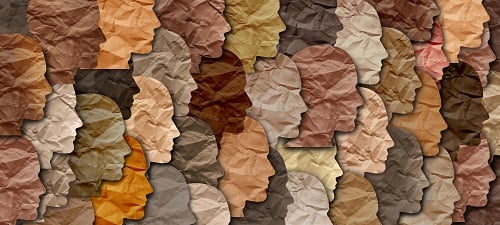Talking About Race in Therapy: How White Psychologists Can Respond to Clients
Talking About Race in Therapy: How White Psychologists Can Respond to Clients

Why Write about White Psychologists Discussing Race?
When we first conceived of this topic, we were eager to collaborate with (a) BIPOC colleague(s) to provide a more diverse perspective in addressing race as it arises in the context of the therapeutic relationship. But we discovered, not surprisingly, that our BIPOC colleagues have been inundated with requests to talk, present, and organize over the past year + and are overextended and exhausted. One example comes from Black colleague, Hayden Dawes, (@hcdawes) who posted on Instagram his experience of managing these mounting requests by learning to say, as much as I'm interested, this is beyond my capacity. His post went viral because many BIPOC have been struggling with wanting to say ‘yes’ but realizing it’s not always possible. So, while we were at first disappointed we could only provide a white perspective, it has reaffirmed what we know to be true: white people need to do this work too. Afterall it is white forebears who established policies and systems that prioritized whiteness which has caused our present inequities, so shouldn’t we (white people) take the lead in righting the wrongs?
As white psychologists, we occupy a space of power and privilege in our community and in therapeutic spaces. Many of us provide suggestions and guidance to the community, as well as to colleagues, supervisees, students, and especially to our clients/patients. Given these facts, we have been wrestling with the following questions: what is our obligation as white psychologists to discuss issues of race with our clients/patients? And, if we do have an obligation, how exactly are we supposed to have these discussions in a helpful way?
Do White Psychologists Have an Obligation to Discuss Race?
Do No Harm: Beneficence and Nonmaleficence
The American Psychological Association’s Ethical Principles of Psychologists and Code of Conduct has five general principles, the first of which outlines that: In their professional actions, psychologists seek to safeguard the welfare and rights of those with whom they interact professionally and other affected persons… In short, we are taught to do no harm. There are numerous ways in which our graduate training prepares us to protect our clients, including learning about the inherent power differential between therapist and client and the cautionaries of boundary crossings.
Respect for People’s Rights and Dignity
The fifth and final general ethical principle states: Psychologists are aware of and respect cultural, individual, and role differences, including those based on age, gender, gender identity, race, ethnicity, culture, national origin, religion, sexual orientation, disability, language, and socioeconomic status, and consider these factors when working with members of such groups. Psychologists try to eliminate the effect of their work of biases based on those factors, and they do not knowingly participate in or condone activities of others based on such prejudices. Here too, we are trained in the importance of respecting the rights and dignities of others, especially our clients. However, while these principles are intended to be general, it is the specificity we need right now to help guide us in navigating discussions about race within the therapeutic context. Without adequate guidance, we are left at best unskilled and at worst vulnerable to disrespecting the rights and dignities of our clients and causing harm.
Ethical Principles in Action
Racial microaggressions provide an excellent example of this. Consider the following: Your white client expresses gratitude that their company has hired more Chinese American accountants, because this will result in the client having an easier time training the new hires as “everyone knows Asians are good at math?” What do you do? And would you respond differently if this client were BIPOC? And because this is an example of a positive stereotype, we ask you to consider whether you would behave differently if the stereotype were negative? And finally, would it change how you respond if the stereotype relates to the reason why your client is seeking treatment? This myriad of queries highlights the complexities we face and the importance of being ready to respond when microaggressions arise. And while we have chosen to discuss race, this extends to matters of sexual orientation, gender, religion, (dis)abilities, age, class, and more. Ultimately, we believe remaining silent or side stepping these moments is harmful and does not respect the rights and dignities of BIPOC. However, it also impacts all of us, because in the words of activist Fannie Lou Hammer, “…nobody's free until everybody's free.”
What We Can Do: Strategies for Discussing Race in Therapeutic Spaces
So what are white psychologists, with all of our ethical guidelines, power, and good intentions, to do? Here are a few ideas:
- Maintain strong therapeutic relationships. Perhaps the most important thing that we can do is to build and maintain good rapport with our clients. A conversation about race within a mutually respectful relationship is much more likely to fit within the ethical principles of beneficence and nonmaleficence, especially because that therapeutic relationship is both a critical factor in treatment success and a buffer for the pain of uncomfortable interactions. Holding the client/patient with positive regard throughout this process will be critical to the maintenance of this therapeutic relationship.
- Be on the “listen-out.” Psychologists are trained to be excellent listeners, thus, it is imperative that white psychologists be more aware of and open to opportunities for racial discussions when they arise during therapy sessions. It is particularly important that both implicit and explicit biases are considered. White psychologists likely need to increase awareness of racial microaggressions (and even more overt statements) than BIPOC psychologists. White psychologists also likely need support in order to be more open to having these conversations in professional settings, so reach out to colleagues or mentors to process how you are navigating these situations as they arise.
- Notice the feelings. Once an opportunity for a race discussion presents itself in session, a logical first step for a psychologist, whose daily currency is emotions, is to notice those emotions in themselves and their clients. Often, the use of a racial stereotype or slur in a therapy session will evoke emotion from both parties. A simple “I notice that you have a lot of negative thoughts about that person” or “I started feeling my face turn red when you used that word” can be a great segue to a deeper conversation. This practice will likely feel uncomfortable for both parties, so having a few standard therapeutic responses (e.g., “It seems like we’re both feeling awkward”) can bring attention to this discomfort, which is really a cue that the topic needs to be further explored.
- Wonder aloud. Another helpful therapeutic tool is to wonder aloud with your client. “I wonder if your Blue Lives Matter shirt tells the whole story you want to tell.” and “I wonder what your kids hear when you called your Black colleague’s hairstyle ‘messy.’” These statements invite further discussion without confrontation, which often shuts the door to learning. Be sure to keep the tone open, inquisitive, and never condescending.
- Be open. Being open to a client’s current understanding of their world and relationships is imperative to sparking changes. Holding space for multiple truths (see “holding the dialectic” in Marsha Linehan’s Dialectical Behavior Therapy) can be particularly helpful. For example, a client who says “My boss is such an angry Black woman” might be able to see how their boss may indeed be angry AND the perpetuation of that stereotype can be damaging to the community of Black women.
- Learn and grow together. Commit to learning alongside clients. White psychologists have an obligation to both improve the lives of our clients and the greater society, just as clients have their own obligations. Seek opportunities to attend workshops, read books and articles, or watch educational videos to expand your knowledge about anti-racism and related topics. And then consider the use of appropriate self-disclosure about one’s own learning as this can do wonders for assuring others that even white psychologists are still working toward the broader goal of anti-racism in personal and professional practice.
Next Steps: Go Forward and Dismantle Systemic Racism
Armed with this knowledge, Is it enough, as the American Psychiatric Association pledged, to “not stand for racism against Black Americans”? Or should we “dismantle racism at every level” like the American Academy of Pediatrics aims to do? We are of the belief that as a discipline we must engage in actions to the fullest extent possible and it can begin with the smallest of interactions between client and therapist.
We have affirmed, then, that white psychologists are obligated to do good for our clients and simultaneously dismantle the racist structures in which we function. In particular, white psychologists are frequently poised to do more of this work, particularly if BIPOC friends and colleagues are overextended and exhausted. I will note (EV), that even in the writing of this piece I have had to use my power and privilege to pause the never-ending pile of client work and make the time to write about this topic. We, as white psychologists, have the capacity and the obligation to continue this work in support of our clients and in support of the BIPOC community. Here’s hoping that these tools will better prepare us for the inevitable discomfort involved in this critical work.













